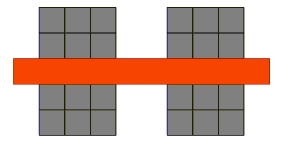Flgas that determine the behavior of the line removal process.
| Visual Basic (Declaration) | |
|---|---|
<FlagsAttribute()> Public Enum LineRemoveCommandFlags Inherits Enum | |
| Visual Basic (Usage) |  Copy Code Copy Code |
|---|---|
| |
| C# | |
|---|---|
[FlagsAttribute()] public enum LineRemoveCommandFlags : Enum | |
| C++/CLI | |
|---|---|
[FlagsAttribute()] public enum class LineRemoveCommandFlags : public Enum | |
| Member | Description |
|---|---|
| None | No flags. |
| UseDpi | The unit of measure for all properties of the LineRemoveCommand is thousandths of an inch. Use the image's DPI to convert to pixels. This allows the processing of many images with different DPI. If this flag is not set, the unit of measure for all properties of the LineRemoveCommand is pixels. |
| SingleRegion | For each line found by LineRemoveCommand, if the LineRemoveCommandEventArgs.Status is set to RemoveStatus.Remove, the removed line is added to an internal single region. If it is set to RemoveStatus.NoRemove, the line is not added to the single region. When LineRemoveCommand returns, either LineRemoveCommand.ImageRegion or LineRemoveCommand.Region will reference a region that contains all the removed lines. If LeadRegion is also set, LineRemoveCommand.ImageRegion will be updated with a shallow copy of image that has a LEAD region that contains all the removed lines. If LeadRegion is not set, LineRemoveCommand.Region is updated with a Windows region that contains all the removed lines. When the region (either LEAD or Windows) is no longer needed, it must be disposed of (either region allocated in LineRemoveCommand.ImageRegion or LineRemoveCommand.Region). |
| LeadRegion | When LineRemoveCommand returns, LineRemoveCommand.ImageRegion is updated with a shallow copy of affected image that also contains a region with all the removed lines. This flag must be used in conjunction with SingleRegion. So set LineRemoveCommand.Flags to SingleRegion | LeadRegion |
| CallBackRegion | The LineRemoveCommandEventArgs.Region property receives a Windows region that contains the current line to be removed. Setting this flag lets the user create his or her own composite of removed lines by combining the regions received, if LineRemoveCommandEventArgs.Status is set to RemoveStatus.Remove. The regions can be combined using a logical OR operator. Combining all regions received when the LineRemoveCommandEventArgs.Status is set to RemoveStatus.Remove results in a region identical to the region created when SingleRegion is set in LineRemoveCommand.Flags. For an example, refer to LineRemoveCommand. When the region received by the LineRemoveCommandEventArgs.Region peroperty is no longer needed, it must be disposed of. |
| ImageUnchanged | The affected image (the Run method image)is unchanged. |
| RemoveEntire |
Remove the entire line, even if the line passes through a character or a wall.
Consider the line below.  Setting iMaxWallPercent as 80 and passing LINE_REMOVE_ENTIRE will remove the red pixels as shown below.  |
| UseGap | Consider "gaps" in lines when performing line removal. If this flag is set, the gap length value (either the LineRemoveCommand.GapLength property or the gapLength parameter of the Constructor) is used. If this flag is not passed, the gap length value is ignored. |
| UseVariance | Consider line variance when performing line removal. If this flag is passed, the variance value (either the LineRemoveCommand.Variance property or the variance parameter of the Constructor) is used. If this flag is not passed, the variance value is ignored. |
You can use a bitwise OR (|) to specify one or more flags.
System.Object
System.ValueType
System.Enum
Leadtools.ImageProcessing.Core.LineRemoveCommandFlags
Target Platforms: Microsoft .NET Framework 2.0, Windows 98, Windows NT 4.0, Windows Millennium Edition, Windows 2000, Windows XP Home Edition, Windows XP Professional, Windows Server 2003 family




